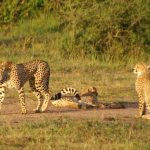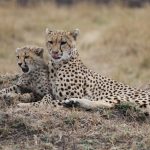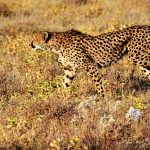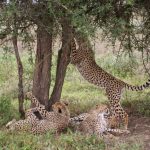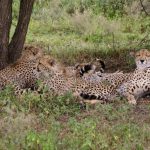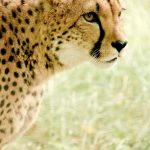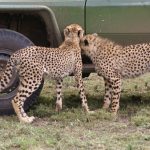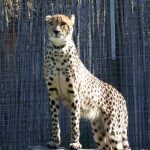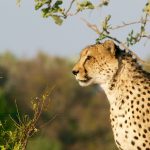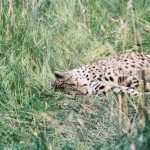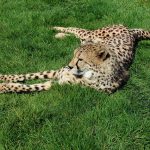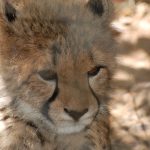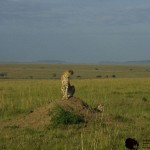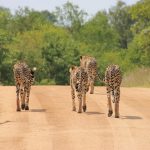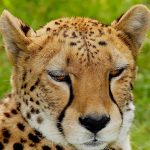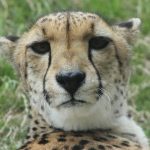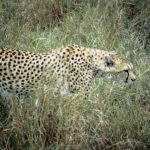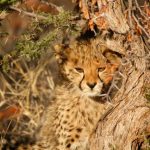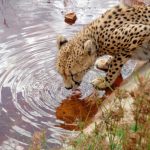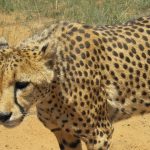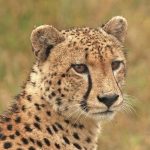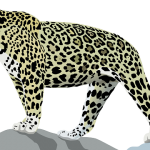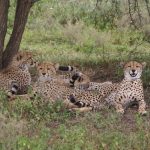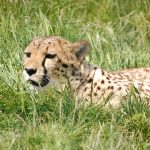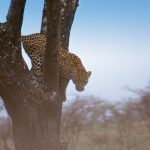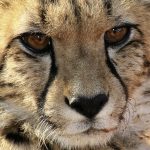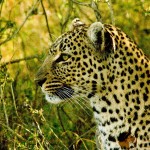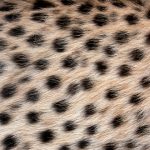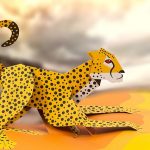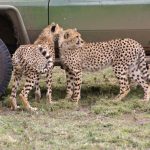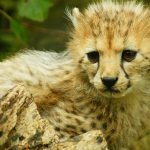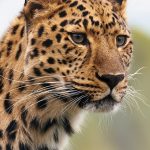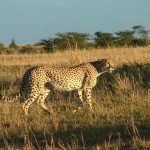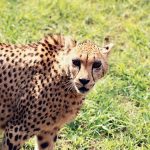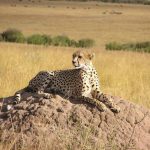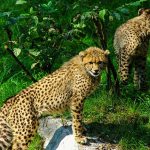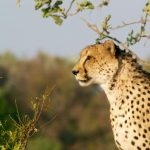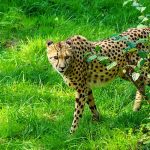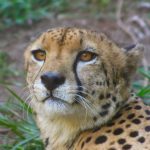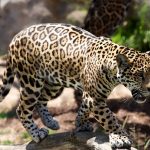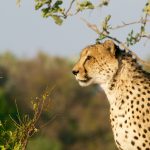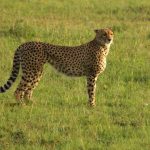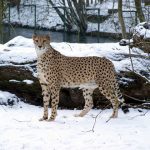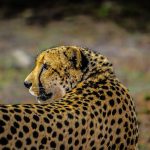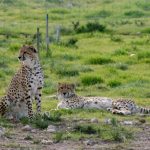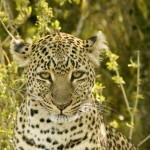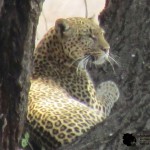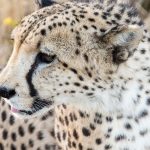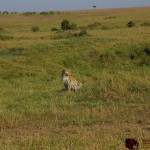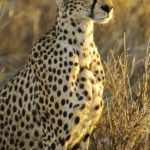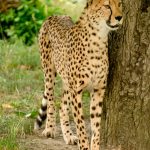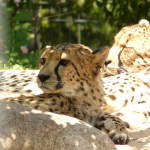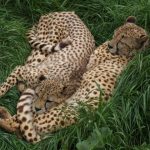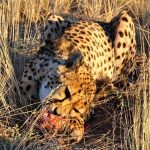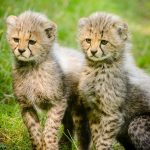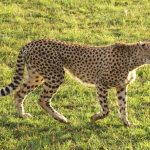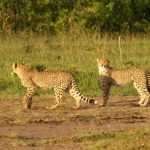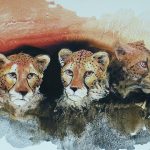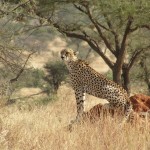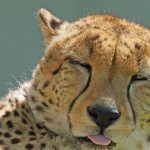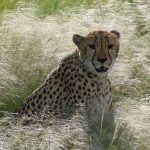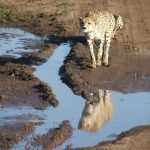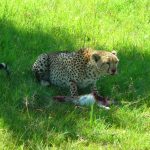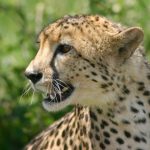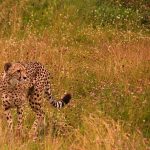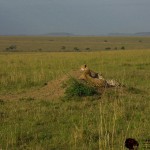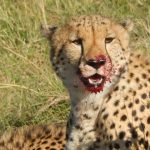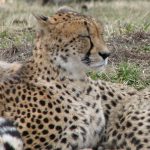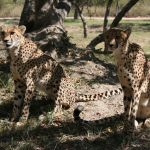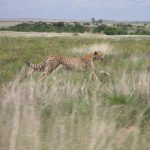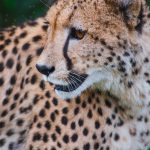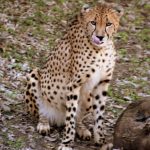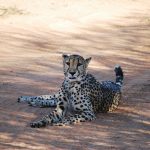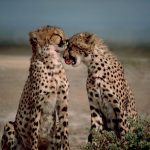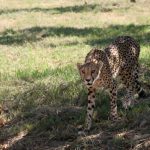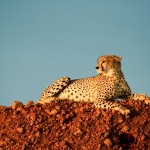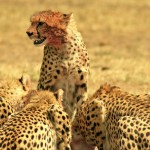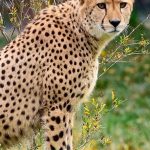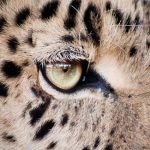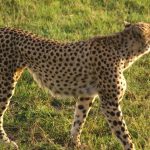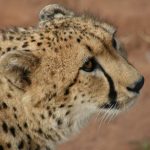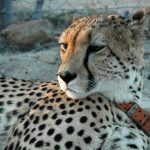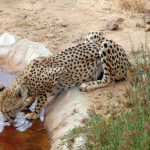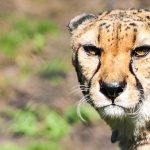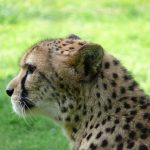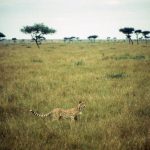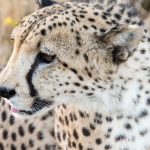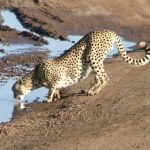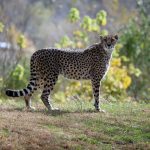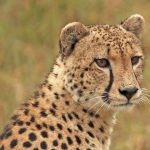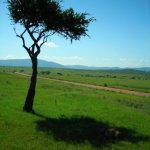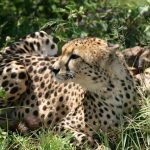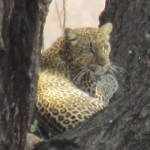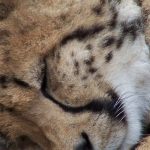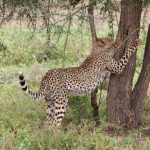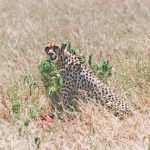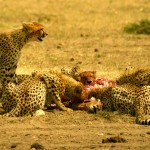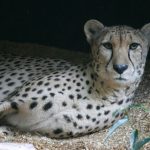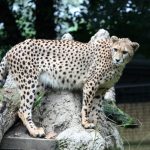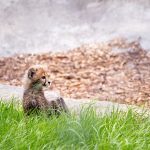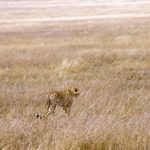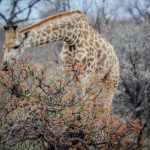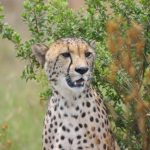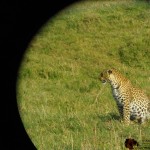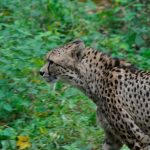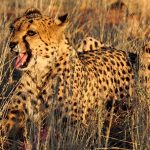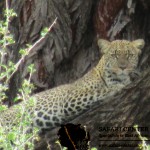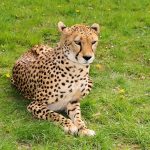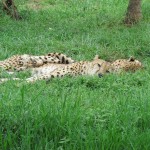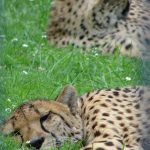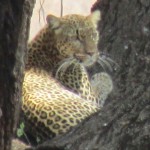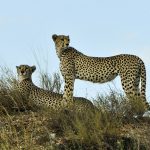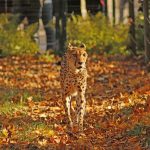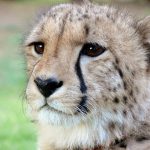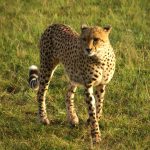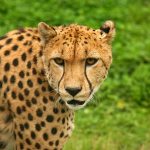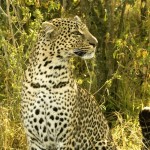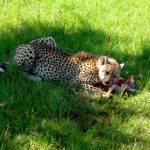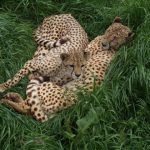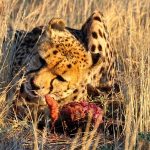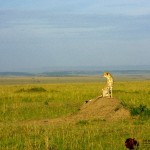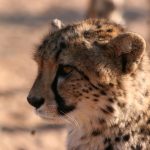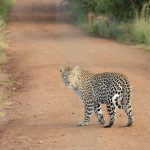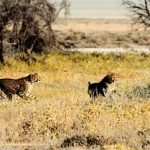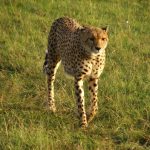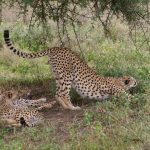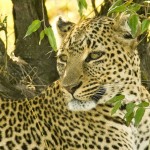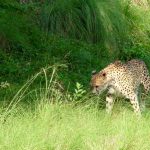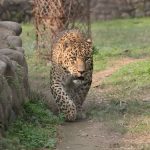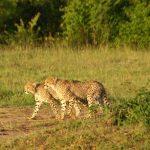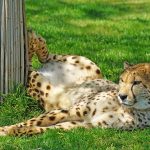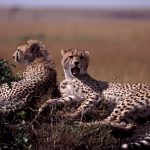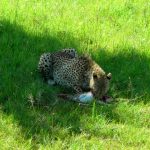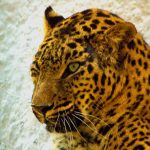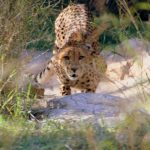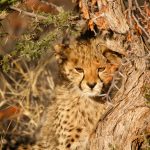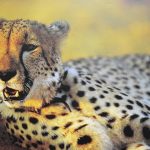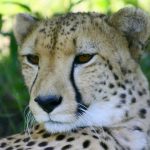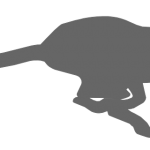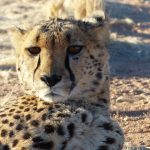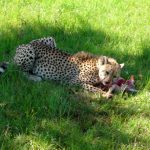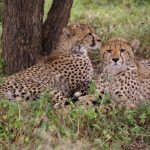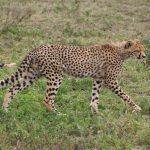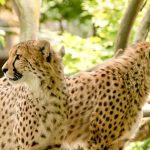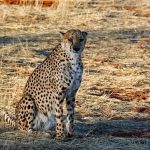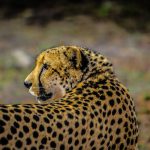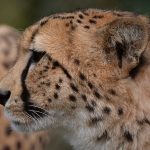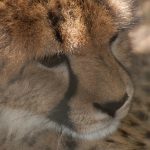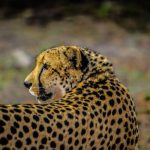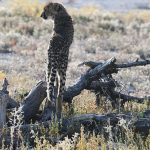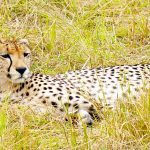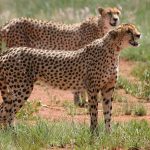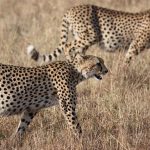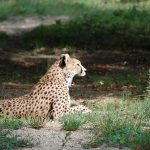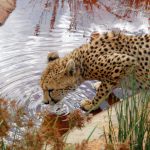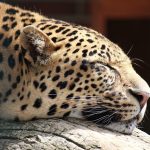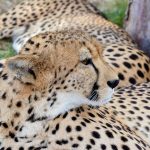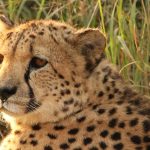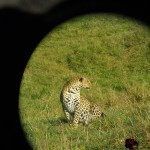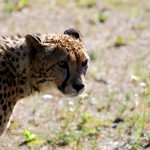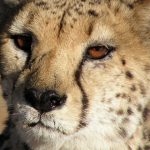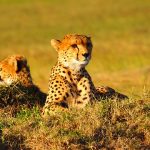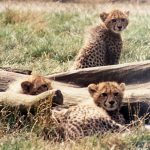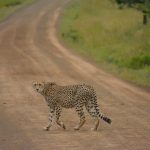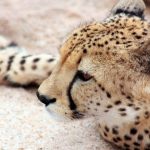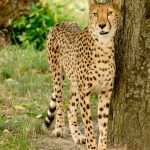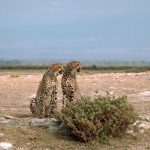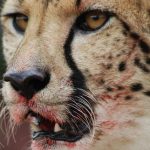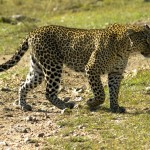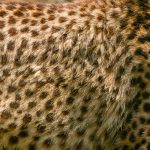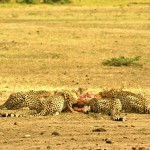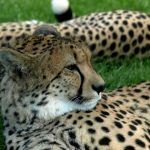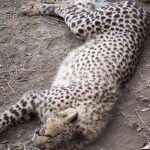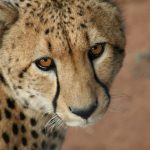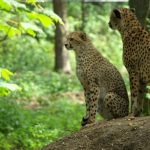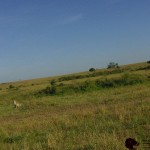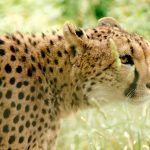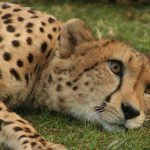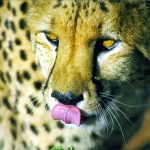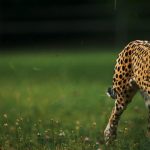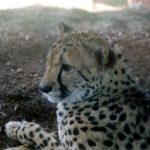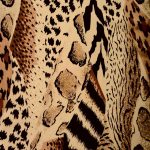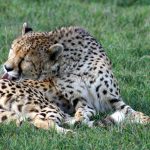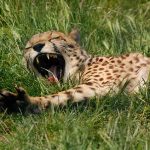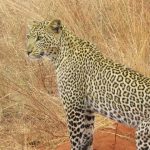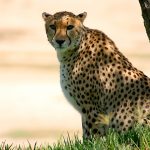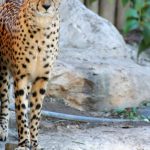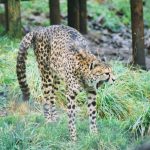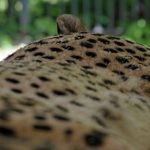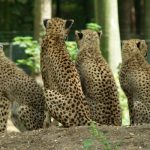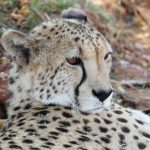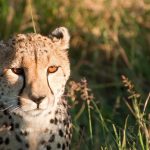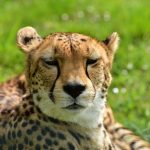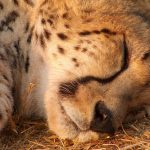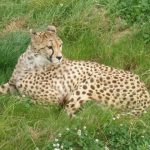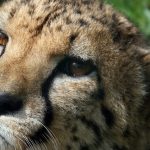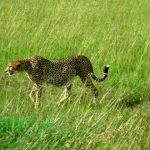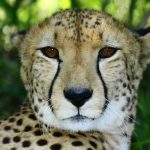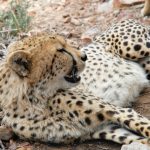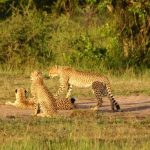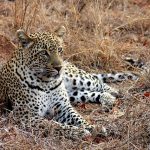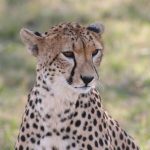- The population of cheetah is estimated to be 7,500 on a global scale
- Cheetahs hunt both alone and in group
- Over the years cheetahs have greatly reduced due to an increase in human population that has led to habitat loss, and a reduction in prey base
- A cheetah hunts alone or in group
- Cheetahs hunt alone or in group
- A cheetah is the fastest animal on earth
- Cheetah population is estimated to be 7,500 worldwide
- Cheetah doesn’t avoid water but swims across rivers
- Over the years cheetahs have greatly reduced due to an increase in the human population that has led to habitat loss, as well as conflicts with people
- A cheetah hunts at night to avoid disturbance and hot weather
- The cheetahs are amongst the most elusive of African animals
- To see the cheetahs whilst on safari is a privilege
- Over the years cheetahs have greatly reduced in numbers due to an increase in the human population that has led to habitat loss, and a reduction in prey base
- The cheetah is amongst the most elusive and beautiful of African animals
- The worldwide population of cheetah is estimated to be 7,500
- A cheetah can run as fast as 120.7 km/h
- Cheetahs were widely distributed across Kenya in the past but over the years, due to various reasons, the numbers have greatly reduced
- The population of cheetah have dropped by 30% during the last 18 years primarily due to anthropogenic factors
- The cheetahs are amongst the most beautiful as well as elusive of African animals
- Globally the population of cheetah is estimated to be 7,500
- Global wild cheetah population is estimated to be 7,500 with the last significant populations remaining in Southern and East Africa
- Global wild cheetah population is estimated to be 7,500 in numbers with the last significant populations remaining in East and Southern Africa and are represented by different subspecies
- A cheetah doesn’t avoid water but swims across rivers
- Cheetahs are the fastest animals on earth
- Cheetah is amongst the most beautiful and elusive of African animals
- Over the years cheetahs have greatly reduced due to human population increase that has led to habitat loss, a reduction in prey base, diseases and poorly managed tourism
- Over the years cheetahs have greatly reduced due to human population increase
- A cheetah is now considered “Vulnerable”
- To see the cheetah whilst on safari is a privilege
- The cheetah is amongst the most beautiful of African animals
- The cheetahs hunt alone or in group
- To see a cheetah on safari is a real privilege
- Over the years cheetahs have greatly reduced in numbers due to an increase in the human population that has led to habitat loss, as well as conflicts with people
- The last significant population of cheetahs remain in East and Southern Africa
- A cheetah hunts both alone and in group
- The cheetah can run faster than any other land animal
- To see the cheetah on safari is a real privilege
- Cheetahs were widely distributed across Kenya in the past but over the years, due to human population increase, conflicts with people, a reduction in prey base, diseases and poorly managed tourism, the numbers have greatly reduced
- Cheetah population is estimated to be 7,500 globally
- Over the years cheetahs have greatly reduced due to conflicts with people
- Over the years cheetahs have greatly reduced due to an increase in human population that has led to habitat loss
- Over the years cheetahs have greatly reduced in numbers due to loss of habitat
- Cheetah is amongst the most elusive as well as beautiful of African animals
- The cheetah doesn’t avoid water
- Over the years cheetahs have greatly reduced in numbers due to habitat loss, conflicts with people, as well as diseases
- The cheetahs don’t avoid water
- The cheetah is considered “Vulnerable”
- Cheetah is amongst the most beautiful of African animals
- Global wild cheetah population is estimated to be 7,500 in numbers with the last significant populations remaining in Southern and East Africa
- Cheetahs are resident now in 23% of their range in Kenya
- The cheetah doesn’t avoid water but swims across rivers
- Over the years cheetahs have greatly reduced in numbers due to diseases
- The cheetahs hunt in group or alone
- To see the cheetahs on safari is a real privilege
- Global wild cheetah population is estimated to be 7,500 wherein the East and South African population of cheetahs are represented by different subspecies
- Cheetahs are amongst the most elusive of African animals
- The global wild cheetah population is 7,500
- Over the years cheetahs have greatly reduced due to poorly managed tourism
- Cheetahs can run faster than any other land animal
- The cheetah hunts at night to avoid disturbance and hot weather
- Over the years cheetahs have greatly reduced due to an increase in the human population that has led to habitat loss, and a reduction in prey base
- There were 15,000 number of cheetahs in Africa during the 1970s
- Cheetahs is a big cats
- Cheetahs can run as fast as 120.7 km/h
- Over the years cheetahs have greatly reduced due to habitat loss, conflicts with people, as well as diseases
- Cheetahs can run as fast as 109.4 km
- The population of cheetah is estimated to be 7,500 world-wide
- Cheetah is known for its incredible speed
- The cheetah is amongst the most elusive of African animals
- A cheetah is amongst the most elusive and beautiful of African animals
- Population of cheetah is estimated to be 7,500 world-wide
- It is estimated that the population of cheetah have dropped by 30% during the last 18 years primarily due to anthropogenic factors
- Over the years cheetahs have greatly reduced due to human population increase that has led to habitat loss, conflicts with people, a reduction in prey base, diseases and poorly managed tourism
- During the last 18 years the population of cheetah have declined by 30%
- Over the years cheetahs have greatly reduced in numbers due to an increase in human population that has led to habitat loss, and a reduction in prey base
- Wild cheetah population is estimated to be 7,500 worldwide
- World-wide cheetah population is estimated to be 7,500
- The cheetah is amongst the most beautiful as well as elusive of African animals
- Over the years cheetahs have greatly reduced in numbers due to human population increase that has led to habitat loss, conflicts with people, a reduction in prey base, diseases and poorly managed tourism
- Over the years cheetahs have greatly reduced due to human population increase, a reduction in prey base, as well as diseases
- The cheetah can run as fast as 120.7 km/h
- A cheetah is amongst the most beautiful and elusive of African animals
- Cheetah is amongst the fastest, the most beautiful as well as elusive of African animals
- Cheetah does not avoid water but swims across rivers
- The cheetah hunts both alone and in group
- World-wide population of cheetah is estimated to be 7,500
- Over the years cheetahs have greatly reduced in numbers due to human population increase
- Cheetah swims across rivers
- Cheetahs were widely distributed across Kenya in the past but over the years, due to human population increase, conflicts with people, a reduction in prey base, diseases as well as poorly managed tourism, the numbers have greatly reduced
- The scientific name for cheetah is Acinonyx jubatus
- A cheetah is amongst the most beautiful of African animals
- Cheetah is the fastest animal on earth
- Population of cheetah is estimated to be 7,500 worldwide
- The East and South African population of cheetahs are represented by different subspecies
- The population of cheetah is estimated to be 7,500 across the world
- Cheetah hunts at night to avoid disturbance and hot weather
- A cheetah does’nt avoid water
- Global wild cheetah population is estimated to be 7,500 with the last significant populations remaining in Southern and East Africa and are represented by different subspecies
- Globally wild cheetah population is estimated to be 7,500
- A cheetah is amongst the most elusive of African animals
- A cheetah is known for its incredible speed
- East and South African population of cheetahs are represented by different subspecies
- Last significant population of cheetahs remain in East and Southern Africa and are represented by different subspecies
- Cheetah can run as fast as 120.7 km/h
- Cheetahs belong to the subfamily Felinae
- Over the years cheetahs have greatly reduced due to an increase in the human population that has led to habitat loss, a reduction in prey base and conflicts with people
- Cheetahs are amongst the most beautiful of African animals
- The last significant population of cheetahs predominantly remain in Southern and East Africa
- The South and East African population of cheetahs are represented by different subspecies
- Global wild cheetah population is estimated to be 7,500
- The cheetah does not avoid water
- Global cheetah population is estimated to be 7,500
- The cheetah hunts in group or alone
- Cheetah is considered “Vulnerable”
- During the last 18 years the population of cheetah worldwide have declined by 30% due to habitat loss and fragmentation
- The cheetahs are known for their incredible speed
- It is estimated that the population of cheetah have declined by 30% during the last 18 years primarily due to anthropogenic factors
- The last significant population of cheetahs remain in East and Southern Africa and are represented by different subspecies
- Global wild cheetah population is estimated to be 7,500 in numbers with the last significant populations remaining in Southern and East Africa and are represented by different subspecies
- A cheetah is amongst the most beautiful as well as elusive of African animals
- Over the years cheetahs have greatly reduced due to human population increase that has led to habitat loss, conflicts with people, a reduction in prey base, diseases as well as poorly managed tourism
- The cheetahs are amongst the most beautiful of African animals
- The cheetahs hunt both alone and in group
- The last significant population of cheetahs predominantly remain in East and Southern Africa
- Cheetahs were widely distributed across Kenya in the past but are resident now in 23% of their range
- Cheetah population is estimated to be 7,500
- The cheetahs are amongst the most elusive as well as beautiful of African animals
- The cheetah swims across rivers
- A cheetah is a big cat
- A cheetah hunts in group or alone
- Cheetahs are resident now in around 23% of their range in Kenya
- The last significant population of cheetahs remain in Southern and East Africa
- Cheetah in the Masai Mara, Africa, 1995. Analogue Film Shot, scanned.
- Cheetah belongs to the subfamily Felinae
- The cheetahs don’t avoid water but swim across rivers
- A cheetah hunts at night
- Over the years cheetahs have greatly reduced in numbers due to human population increase that has led to habitat loss, conflicts with people, a reduction in prey base, diseases as well as poorly managed tourism
- South and East African population of cheetahs are represented by different subspecies
- Global wild cheetah population is estimated to be 7,500 with the last significant populations remaining in East and Southern Africa
- A cheetah does not avoid water
- Cheetah can run as fast as 109.4 km
- Cheetahs hunt in group or alone
- To see cheetah on safari is a real privilege
- A cheetah can run faster than any other land animal
- The cheetah is known for its incredible speed
- The cheetah is a big cat
- The population of cheetah have declined by 30% during the last 18 years due to anthropogenic factors
- Cheetahs are known for their incredible speed
- Over the years cheetahs have greatly reduced in numbers due to human population increase, a reduction in prey base, and diseases
- Population of cheetah is estimated to be 7,500 on a global scale
- Cheetahs inhabit most of Africa and parts of Iran
- The last significant population of cheetahs remain in Southern and East Africa and are represented by different subspecies
- The population of cheetah in the world have dropped by 30% during the last 18 years
- Cheetah is now considered “Vulnerable”
- The cheetah is now considered “Vulnerable”
- Cheetahs are now considered “Vulnerable”
- Cheetahs are amongst the most elusive and beautiful of African animals
- Wild cheetah population is estimated to be 7,500 globally
- The global population of cheetah is estimated to be 7,500
- Scientific name for cheetah is Acinonyx jubatus
- Over the years cheetah numbers have greatly reduced
- Global cheetah population is estimated to be 7,500
- The world-wide population of cheetah is estimated to be 7,500
- Cheetahs are amongst the most beautiful as well as elusive of African animals
- Cheetahs inhabit parts of Iran and most of Africa
- Globally cheetah population is estimated to be 7,500
- The cheetah is amongst the most beautiful and elusive of African animals
- Global wild cheetah population is estimated to be 7,500 in numbers with the last significant populations remaining in East and Southern Africa
- Over the years cheetahs have greatly reduced in numbers due to an increase in human population that has led to habitat loss, and conflicts with people
- To see a cheetah whilst on safari is a privilege
- Cheetah uses a slow-speed hunt or full-speed-chase
- Cheetahs hunt at night to avoid disturbance and hot weather
- Cheetah is a big cat
- Cheetahs don’t avoid water
- A cheetah uses a slow-speed hunt or full-speed-chase
- The population of cheetah have declined by 30% during the last 18 years primarily due to anthropogenic factors
- The population of cheetah is estimated to be 7,500 worldwide
- Over the years cheetahs have greatly reduced due to human population increase, a reduction in prey base, and diseases
- Over the years cheetahs have greatly reduced due to an increase in the human population that has led to habitat loss
- The cheetahs are considered “Vulnerable”
- Worldwide population of cheetah is estimated to be 7,500
- Cheetahs hunt at night
- Wild cheetah population is estimated to be 7,500 world-wide
- Global wild cheetah population is estimated to be 7,500 in numbers wherein the East and South African population of cheetahs are represented by different subspecies
- Over the years cheetahs have greatly reduced in numbers due to an increase in human population that has led to habitat loss, as well as conflicts with people
- Population of cheetah is estimated to be 7,500 globally
- The cheetahs are amongst the most elusive and beautiful of African animals
- Over the years cheetahs have greatly reduced in numbers due to loss of habitat, conflicts with people, and diseases
- The population of cheetah is estimated to be 7,500 globally
- The cheetah hunts alone or in group
- Population of cheetah is estimated to be 7,500 across the world
- To see cheetahs whilst on safari is a privilege
- Cheetah doesn’t avoid water
- Over the years cheetahs have greatly reduced due to a reduction in prey base
- Over the years cheetahs have greatly reduced due to loss of habitat
- Cheetahs were widely distributed across Kenya in the past
- Over the years cheetahs have greatly reduced in numbers due to an increase in the human population that has led to habitat loss, a reduction in prey base and conflicts with people
- Cheetah is amongst the most elusive and beautiful of African animals
- Global wild cheetah population is estimated to be 7,500 with the last significant populations remaining in East and Southern Africa and are represented by different subspecies
- Over the years cheetahs have greatly reduced due to an increase in human population that has led to habitat loss, and conflicts with people
- Over the years cheetahs have greatly reduced in numbers due to human population increase that has led to habitat loss, a reduction in prey base, diseases and poorly managed tourism
- Cheetahs don’t avoid water but swim across rivers
- Over the years cheetahs have greatly reduced in numbers due to an increase in human population that has led to habitat loss
- Over the years cheetahs have greatly reduced in numbers due to conflicts with people
- Cheetahs are amongst the fastest, the most beautiful as well as elusive of African animals
- Cheetahs do not avoid water but swim across rivers
- Over the years cheetahs have greatly reduced in numbers due to an increase in the human population that has led to habitat loss
- Over the years cheetahs have greatly reduced due to habitat loss, conflicts with people, and diseases
- Over the years cheetahs have greatly reduced due to diseases
- Over the years cheetahs have greatly reduced due to an increase in human population that has led to habitat loss, as well as conflicts with people
- Over the years cheetahs have greatly reduced in numbers due to poorly managed tourism
- The cheetahs do not avoid water but swim across rivers
- Over the years cheetahs have greatly reduced in numbers due to human population increase, a reduction in prey base, as well as diseases
- The cheetahs are amongst the most beautiful and elusive of African animals
- Over the years cheetahs have greatly reduced in numbers due to a reduction in prey base
- It is believed that the population of cheetah have declined by 30% during the last 18 years primarily due to anthropogenic factors
- The cheetah belongs to the subfamily Felinae
- The cheetah is amongst the fastest, the most beautiful as well as elusive of African animals
- Over the years cheetahs have greatly reduced due to an increase in the human population that has led to habitat loss, and conflicts with people
- Over the years cheetahs have greatly reduced in numbers due to an increase in the human population that has led to habitat loss, and conflicts with people
- Population of cheetah is estimated to be 7,500
- Last significant population of cheetahs remain in Southern and East Africa and are represented by different subspecies
- Cheetahs are considered “Vulnerable”
- The cheetahs swim across rivers
- Over the years cheetahs have greatly reduced in numbers
- Worldwide cheetah population is estimated to be 7,500
- To see cheetah whilst on safari is a privilege
- To see cheetahs on safari is a real privilege
- The population of cheetah is said to be decreasing
- A cheetah is considered “Vulnerable”
- Cheetah hunts at night to avoid disturbance
- Cheetah can run faster than any other land animal
- Cheetahs are amongst the most elusive as well as beautiful of African animals
- The cheetahs are the fastest animals on earth
- During the last 18 years the population of cheetah in the world have dropped by 30%
- A cheetah belongs to the subfamily Felinae
- The cheetah uses a slow-speed hunt or full-speed-chase
- Cheetah hunts in group or alone
- Cheetahs swim across rivers
- Cheetahs use a slow-speed hunt or full-speed-chase
- The cheetah can run as fast as 109.4 km
- Wild cheetah population is estimated to be 7,500
- The cheetah is amongst the most elusive as well as beautiful of African animals
- Cheetahs are amongst the most beautiful and elusive of African animals
- The cheetah hunts at night
- Over the years cheetahs have greatly reduced in numbers due to habitat loss, conflicts with people, and diseases
- Cheetah hunts at night to avoid hot weather
- The cheetahs use a slow-speed hunt or full-speed-chase
- The cheetahs are amongst the fastest, the most beautiful as well as elusive of African animals
- The cheetah does not avoid water but swims across rivers
- The cheetah is the fastest animal on earth
- The cheetah hunts at night to avoid hot weather
- Cheetah does not avoid water
- Globally cheetah population is estimated to be 7,500
- The cheetah hunts at night to avoid disturbance
- A cheetah hunts at night to avoid hot weather
- A cheetah swims across rivers
- A cheetah hunts at night to avoid disturbance
- Cheetah is amongst the most elusive of African animals
- Over the years cheetahs have greatly reduced due to loss of habitat, conflicts with people, and diseases
- A cheetah is amongst the most elusive as well as beautiful of African animals
- Cheetahs do not avoid water
- A cheetah does not avoid water but swims across rivers
- It is believed that the population of cheetah have dropped by 30% during the last 18 years primarily due to anthropogenic factors
- The cheetahs hunt at night
- Cheetah population is estimated to be 7,500 world-wide
- Cheetah hunts alone or in group
- Global population of cheetah is estimated to be 7,500
- The cheetahs are now considered “Vulnerable”
- Cheetah is amongst the most beautiful as well as elusive of African animals
5 facts about cheetah
- The height of cheetah is 66-94 cm
- A cheetah can accelerate its speed from 0 to 60 mph in three seconds
- Puma and jaguarundi of the Americas are cheetah’s closest extant relatives
- World’s fastest land mammal is cheetah
- Cheetahs can make quick and sudden turns
To receive a colourful digibook about cheetah with videos, images and text, please fill out the following form or simply email us on safaris@safari-center.com

